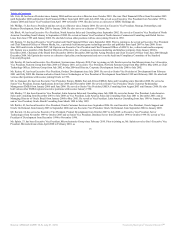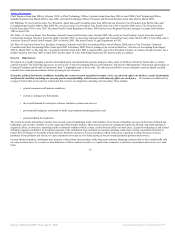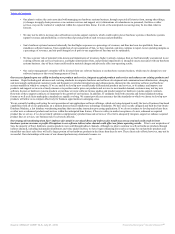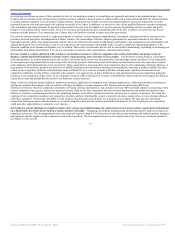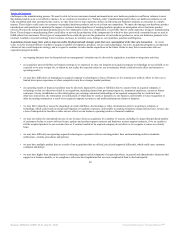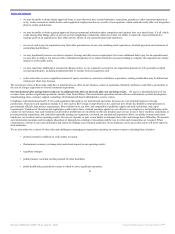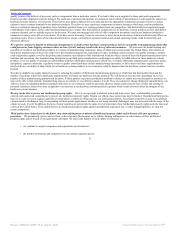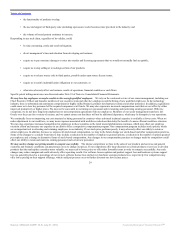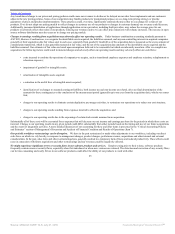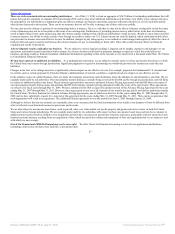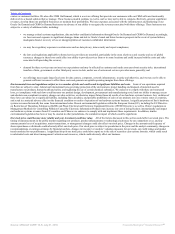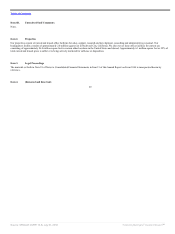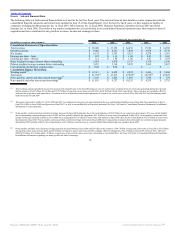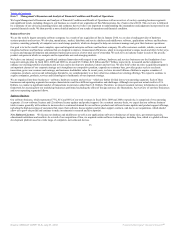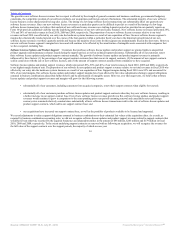Oracle 2009 Annual Report Download - page 29
Download and view the complete annual report
Please find page 29 of the 2009 Oracle annual report below. You can navigate through the pages in the report by either clicking on the pages listed below, or by using the keyword search tool below to find specific information within the annual report.
Table of Contents
Any broad-based change to our prices and pricing policies could cause our revenues to decline or be delayed as our sales force implements and our customers
adjust to the new pricing policies. Some of our competitors may bundle products for promotional purposes or as a long-term pricing strategy or provide
guarantees of prices and product implementations. These practices could, over time, significantly constrain the prices that we can charge for certain of our
products. If we do not adapt our pricing models to reflect changes in customer use of our products or changes in customer demand, our revenues could decrease.
Additionally, increased distribution of applications through application service providers, including SaaS providers, may reduce the average price for our
products or adversely affect other sales of our products, reducing our revenues unless we can offset price reductions with volume increases. The increase in open
source software distribution may also cause us to change our pricing models.
Charges to earnings resulting from acquisitions may adversely affect our operating results. Under business combination accounting standards pursuant to
ASC 805, Business Combinations, we recognize the identifiable assets acquired, the liabilities assumed, and any non-controlling interests in acquired companies
generally at their acquisition date fair values and, in each case, separately from goodwill. Goodwill as of the acquisition date is measured as the excess amount of
consideration transferred, which is also generally measured at fair value, and the net of the acquisition date amounts of the identifiable assets acquired and the
liabilities assumed. Our estimates of fair value are based upon assumptions believed to be reasonable but which are inherently uncertain. After we complete an
acquisition, the following factors could result in material charges and adversely affect our operating results and may adversely affect our cash flows:
• costs incurred to combine the operations of companies we acquire, such as transitional employee expenses and employee retention, redeployment or
relocation expenses;
• impairment of goodwill or intangible assets;
• amortization of intangible assets acquired;
• a reduction in the useful lives of intangible assets acquired;
• identification of or changes to assumed contingent liabilities, both income tax and non-income tax related, after our final determination of the
amounts for these contingencies or the conclusion of the measurement period (generally up to one year from the acquisition date), whichever comes
first;
• charges to our operating results to eliminate certain duplicative pre-merger activities, to restructure our operations or to reduce our cost structure;
• charges to our operating results resulting from expenses incurred to effect the acquisition; and
• charges to our operating results due to the expensing of certain stock awards assumed in an acquisition.
Substantially all of these costs will be accounted for as expenses that will decrease our net income and earnings per share for the periods in which those costs are
incurred. Charges to our operating results in any given period could differ substantially from other periods based on the timing and size of our future acquisitions
and the extent of integration activities. A more detailed discussion of our accounting for these and other items is presented in the “Critical Accounting Policies
and Estimates” section of Management’s Discussion and Analysis of Financial Condition and Results of Operations (Item 7).
Our periodic workforce restructurings can be disruptive. We have in the past restructured or made other adjustments to our workforce, including our direct
sales force on which we rely heavily, in response to management changes, product changes, performance issues, acquisitions and other internal and external
considerations. In the past, sales force and other restructurings have generally resulted in a temporary lack of focus and reduced productivity. These effects could
recur in connection with future acquisitions and other restructurings and our revenues could be negatively affected.
We might experience significant errors or security flaws in our software products and services. Despite testing prior to their release, software products
frequently contain errors or security flaws, especially when first introduced or when new versions are released. The detection and correction of any security flaws
can be time consuming and costly. Errors in our software products could affect the ability of our products to work with other
25
Source: ORACLE CORP, 10-K, July 01, 2010 Powered by Morningstar® Document Research℠


